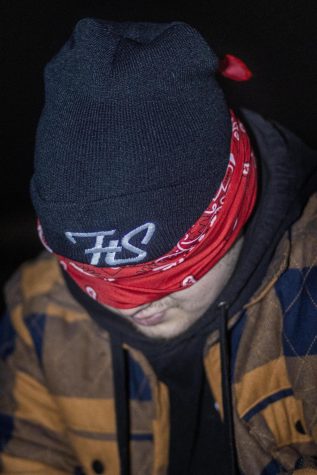Investigating Airtight Bridge
A local paranormal investigation crew looks into the site of Coles County’s most haunting murder.
October 26, 2022
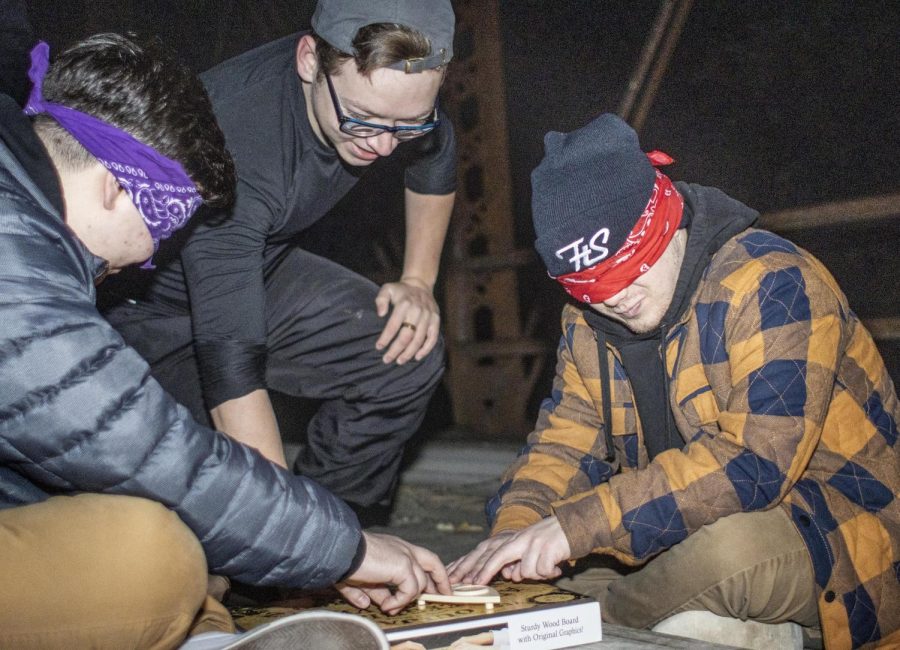
As I put on a blindfold and noise canceling headphones, I felt a chill run through me.
It might have only been the temperature dropping to near freezing as the clock struck midnight.
In my hands, connected to the headphones, I held what paranormal investigators call a “spirit box.” The device quickly skims radio frequencies, reversing the audio to avoid radio chatter and allow possible ghosts to speak through it.
The static and blips of radio noise were the only thing I could hear, depriving me of all other senses. This way, I wouldn’t be influenced by questions asked by investigators. I’d only say out loud whatever words I thought I heard. This is called the Estes Method, named after the park where it was first used in an investigation of the Stanley Hotel.
But it didn’t matter, really, what they called the gadget when I started hearing sounds that assembled together for words – or, at least that’s what I believe I heard at the Airtight Bridge midst farm fields and the occasional home in the Northeastern part of Coles County with a group of young, enthusiastic ghost hunters.
Finding the Specter
Bradyn Wambach stood a few paces away from me on the one-lane steel bridge that spans a narrower stretch of the Embarras River, almost directly over the spot where a body was found sans head, feet and hands in 1980. The head of the murdered woman was never found – although the person who killed and decapitated the body was ultimately captured decades later.
Wambach, the lead investigator, founded the group Finding the Specter, a paranormal investigator group, in part because of his fascination with local history and the stories behind haunted locations.
Wambach credits his interest in the paranormal to watching “Ghost Adventures” as he grew up.
“I think people forget that they [spirits] were real people,” Wambach said. “We try to find out their stories.”
Many ghost stories in central Illinois have been somewhat overlooked by big-name investigators in lieu of more famous locations, so Wambach organized FTS Paranormal with the idea of looking into those spots.
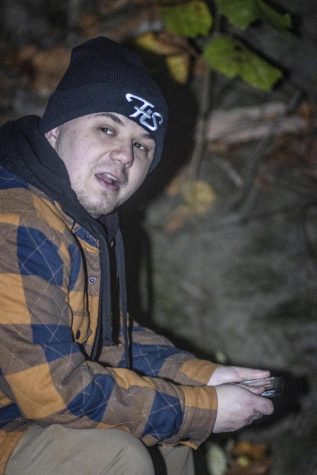
Staying in the area also allows members to participate while still working day jobs. Traveling to famous haunts can get expensive, though the group has some ideas about where to go when they can.
Alongside Wambach, FTS Paranormal includes three investigators: Tristen Marlow, Lizzy Mowen, Gentry Copsy and a technical lead, Hunter Brooks.
While his main focus is editing videos and manning equipment on investigations, Brooks has had his share of scary paranormal experiences.
At the so-called Witch’s Grave at St. Omer Cemetery in Coles County, Brooks believes a spirit tried to demonstrate to him the way in which she died.
The Witch’s Grave is an orb-shaped headstone which actually marks four graves: Granville and Sarah Barnes, their son Marcus, and Marcus’ wife, Caroline are all buried there.
While little reliable history about this family has stuck around, the headstone lists that Caroline died in 1882.
Specifically, the stone marks her death date as Feb. 31, 1882, a day which never existed.
Skeptics blame the date on some kind of typographical error, but some believe it was marked intentionally to avoid the resurrection of this accused witch.
As the story goes, Caroline was hanged for her crimes of witchcraft, but foretold that she would come back to life on the anniversary of her death. Marking the date as one that didn’t exist would prevent her from returning.
“We had spread out some, and I stayed at the grave to try some communication myself,” Brooks said. “About 10 minutes in, I felt a tightness around my throat, and I was having a hard time breathing. It got to the point I had to step away from the grave to catch my breath.”
Mowen, meanwhile, says she was physically attacked at Ashmore Estates. She shows photos of the scratches that run down her shoulder to us.
Yet this newest member of the group somehow is even more eager: “To be honest, it makes me more excited for future investigations, just tells me to be a little bit more cautious.”
Each member of the group has stories about encounters, which we heard throughout the night.
Some of these experiences have been recorded or livestreamed. Videos can be found on Finding the Specter’s social media, under fts_paranormal on most platforms.
Making contact
It was on that social media that I discovered Finding the Specter and reached out. Wambach and I spoke extensively as I will always listen to a good ghost story,
The next big excursion planned for FTS is a return to Ashmore Estates on Nov. 14. Video from the group’s most recent visit will drop on their YouTube channel on Halloween, and they all recounted exciting stories from the location.
Knowing I had a deadline, Wambach generously offered to set up a smaller investigation to show me the works, provided FTS could still film content.
He suggested Airtight Bridge.
The location doesn’t belong to anyone so we could visit any time, and the story behind potential ghosts in the area is as haunting as they come.
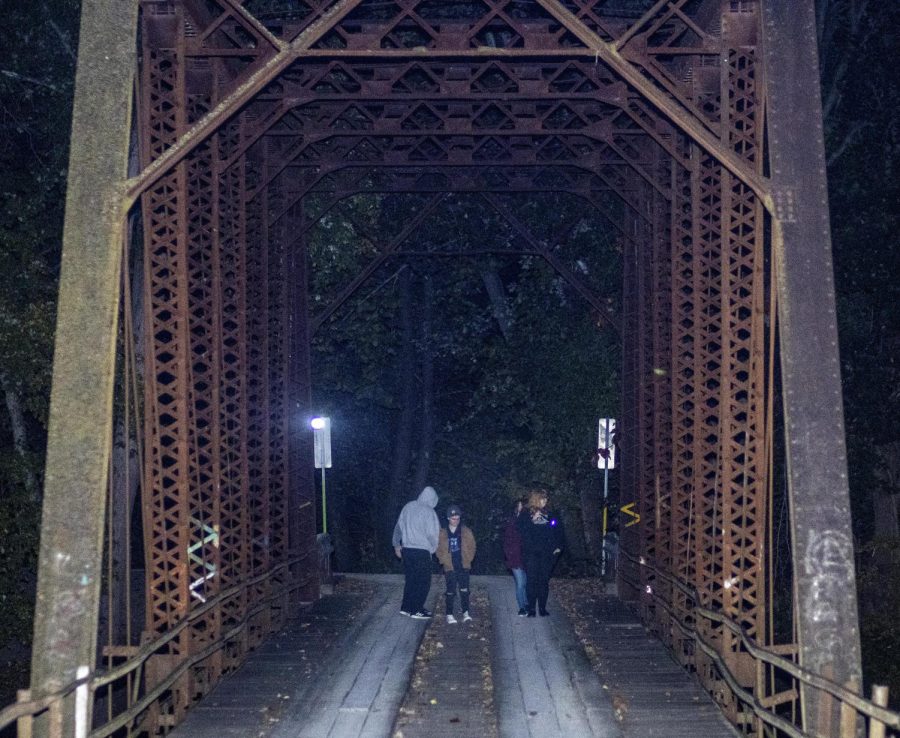
Airtight Bridge
It’s an ideal spot for scary stories: out in the middle of nowhere, Airtight Road crosses the Embarrass River. The valley means most phones don’t get signal and the bridge creaks and groans as we walked on it.
It was also the site where, in 1980, a woman’s body was discovered, missing its head, feet and hands.
It wasn’t until 1992 that newer DNA tracing system allowed police to identify the body as Diana Small of Bradley, Ill.
The main suspect in the case was Small’s husband, Thomas Small, but interrogations and evidence weren’t sufficient to prove he was the killer. The case went unsolved until it was reopened in 2016, and police were able to get a confession.
Small said that during an argument with his wife, she “started swinging” at him. He retaliated by swinging back with a coal poker – a short, rigid rod often made of iron.
“I might have hit her more than once,” Small said, according to a Kankakee Daily Journal article.
He took her body to the attic until it began to smell too strongly, when he loaded it in his car and brought his young daughter along, as she was too young to be left alone.
Small apparently drove at random until he found the Airtight Bridge, where he dismembered the body. He took the head, hands and feet back to his residence and burned them in an attempt to keep the body from being identified.
Twenty-seven years later, the 71-year-old Small was sentenced to 30 years in prison after pleading guilty to first-degree murder in 2017.
The ghost story of Airtight Bridge continues to be passed on.
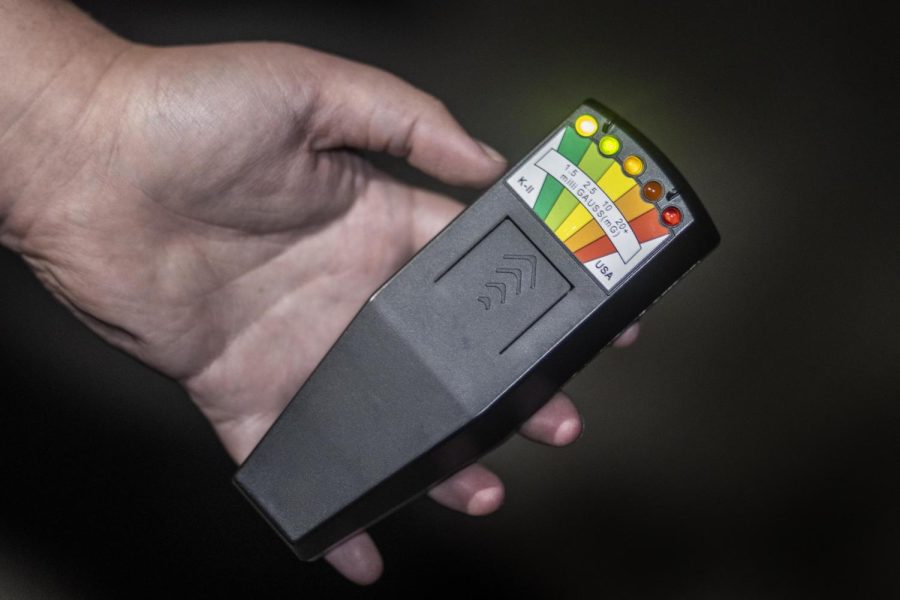
Our investigation
We arrived at Airtight Bridge around 10 p.m. at the same time, oddly, as another group who wanted to investigate, but we mostly stayed out of each other’s way.
I brought along an advisor who was interested in the story and a photographer whose talents I would definitely need on such a dark night. Fortunately, the whole FTS team was able to be there.
To begin, FTS gave us a brief rundown of the equipment they use, like the aforementioned spirit box.
Another popular device: an electromagnetic field detector that detects electromagnetic frequencies and displays levels on an LED display. Pointing it at other electronics will set it off, so FTS has two types at different sensitivities to avoid false alarm from their own smartphones.
Despite being in a field which is by nature difficult to interact with scientifically, the investigators try to avoid creating any false evidence.
They also use cat balls, which are exactly what they sound like. These little round cat toys light up when they’ve been physically moved. We did some stomping around where they were set on the bridge to confirm that we wouldn’t trigger them by mistake.
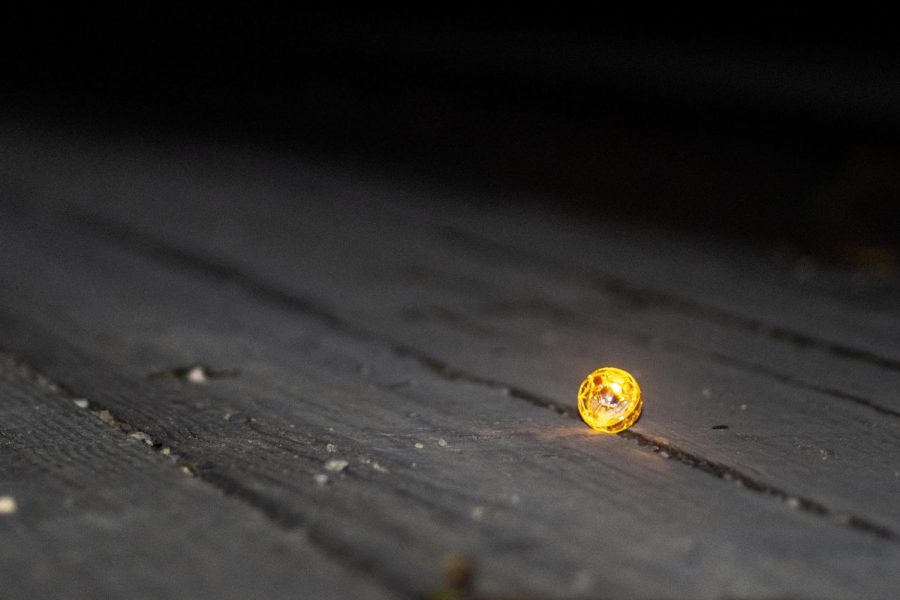
The cat balls were the first thing to go off, as it turned out.
The group dispersed to both sides of the river as soon as they’d finished explaining the game plan. I’d been wandering a bit myself when I turned to see Copsy overlooking a colorfully flashing ball.
“Do you like the pretty colors?” Copsy asked.
The ball flashed again.
“If someone is here, could you light up the other ball for me?”
Nothing. We watched more. I held my breath.
“Okay, I guess you like this one. Could you light it up again?”
The ball flashed.
Suddenly, the members of the team on one side of the bridge starting yelling and running. We whipped around.
“Run, there’s a car! Grab the cat balls!”
Everyone scrambled, because that bridge is only wide enough for one car.
The truck slowly drove past, the driver laying on a cartoonishly old-fashioned sounding horn. The vintage truck might have served to add to the spooky experience, if it weren’t for its shiny new license plates.
We set the cat balls back where we had them and started asking questions again, but whatever was triggering them had departed. They didn’t light up again.
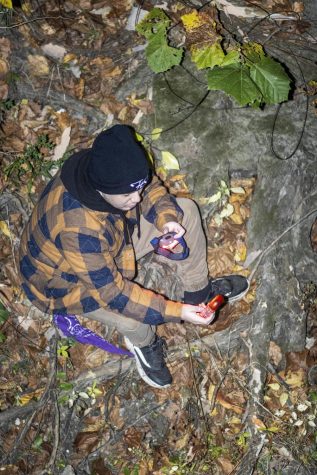
Under the bridge, Wambach was experimenting with an app called “Necrophonic,” which he’d found but was pretty skeptical of.
The app scrambles different sets of random noise, constructed from scrambled audio of people talking. The idea is that ghosts would be able to manipulate the disjointed sounds into understandable words.
Wambach said that since it was just a smartphone app, he felt it would be very easy for its creator to have tampered with it in some way to include some full words and phrases and trick users into thinking they’d heard a ghost.
While none of the investigators thought he found anything conclusive, the app did call out “Deacon” at one point, which is Brook’s nickname that hadn’t been mentioned during our time there.
Eventually, he decided to give it a rest and we climbed out from under the bridge.
It was time to try using the Ouija board, a board filled with letters also called a spirit board.
Along with the board is a planchette, a piece of wood or plastic shaped sort of like the “spade” symbol on a deck of cards, but with a hole through the center.
Playing the Ouija means that multiple people rest their fingers on the planchette, then invite spirits to move it. Symbols are read through the hole; it can circle letters to spell out words, or the “YES” and “NO” written along one side of the board.
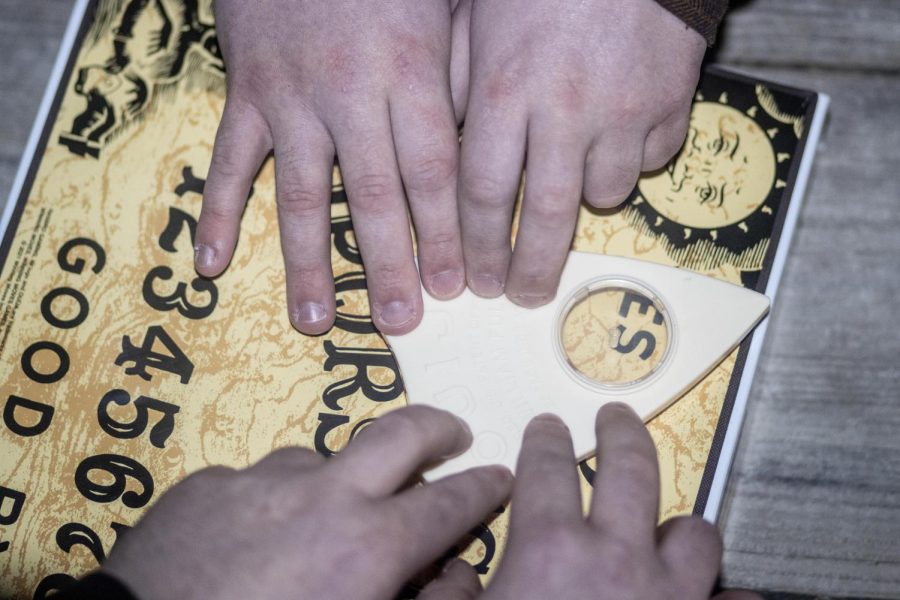
Marlow refused to touch it, initially not even wanting to stand too close.
The Ouija board, though originally a family party game, has become a star of the horror genre. Supposedly, misuse could lead to demonic possession.
“My family has had bad experiences with the Ouija board throughout the generations,” Marlow said.
His mother and other family members played with a Ouija board in their home years ago and, despite “cleansing” the area with sage, they returned to find items moved and thrown about their house.
The idea of sage cleansing is derivative of the Native American practice of “smudging.” Lighting a bound wad of dried sage and spreading the smoke through a space is meant to clear out any negative energy held there.
Marlow reconciled to read the letters on the board as the planchette moved around. Mowen and Brooks listened intently to the spirit box in hopes that the Ouija might draw something in.
Copsy and Wambach blindfolded themselves, placed their hands on the planchette and moved it in circles across the alphabet on the board.
“We open ourselves to anything that would like to make communication with us, but after we close this board, you are to go back wherever you came from. You are not welcome to follow us, you are not welcome to be with us. You’re only welcome to be here at the bridge communicating with us,” Wambach said. “If there’s any entity who would like to make itself known, can you give us a sign?”
It was around 11:30 p.m., and freezing, especially over the river. We couldn’t hear much other than the rhythmic channel-switching of the spirit box.
The group relaxed a bit as the planchette remained mostly motionless, beginning to joke about sounds coming through the spirit box or the ominous creaking of the bridge.
Wambach kept attempting to speak to spirits, inviting them to spell out their names or set off any of the cat balls and EMF detectors in the area. He was still looking for the stories of any ghosts who might have been present.
“You’re welcome to use my energy,” Wambach said. “Do you need help? What happened to you?”
Marlow shook his head at Wambach despite the blindfold. He’d said it was his role to stop Wambach from going “too far” and putting himself in danger.
For example, Wambach wasn’t supposed to invite spirits to attach themselves to him in any way.
“You say a lot of things you shouldn’t,” Marlow said.
Still, the majority of the Ouija session was uneventful. The planchette moved to a definitive “yes” in response to some unknown question, then across the letters H, B and F before somewhat trailing off.
Wambach continued to encourage whatever presence may have been there, even asking it to make physical contact with him, much to Marlow’s chagrin.
Eventually, though, the cold became too much, and we had to stand up and get moving.
Wambach and Copsy (who was cold enough he could barely feel his legs) ended the session and moved the planchette across the “GOODBYE” written on the board.
After a short break, it was finally time to try the Estes Method, which I’d been interested in witnessing since Wambach first explained it to me.
Copsy was the one to “go under,” since he usually takes that role in investigations.
The rest of the group placed cat balls near him and then backed up until he said he couldn’t hear them talking at all.
With Copsy’s blindfold and headphones, he would only be able to hear one half of the “conversation.” The other investigators could ask questions and call on any present spirits, and Copsy would be less likely to be influenced by their questions when parsing out the audio.
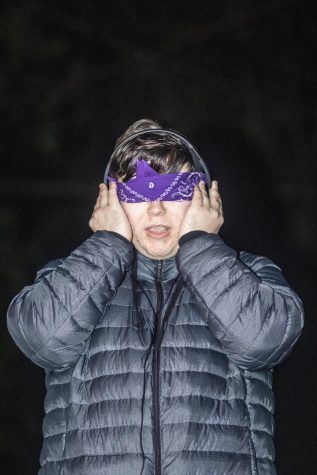
Some of what he called out was pretty nonsensical.
“Up” or “go up” was repeated a few times. We did not have anywhere to go up.
Sometimes, someone’s question would get stopped halfway with “quiet” or even “shut up.”
We heard “smirking,” “seven” and several repeats of “hi” or “hello.”
We got some more relevant responses when the photographer began getting closer to get photos of Copsy.
“Back up. Get back.”
A few times, the camera’s flash was met with a “stop” or “bad.”
We ignored it, for the most part, so if any ghosts are haunting Rob Le Cates’ photos, we may have an explanation.
After a while of going back and forth, Copsy suddenly took off the blindfold and headphones.
“You done?” Brooks asked. “What happened?”
“I heard a really deep voice and it scared the f*** out of me,” Copsy said.
He went on to explain that he wasn’t really sure what he’d heard, but the surprisingly low voice worried him enough that he wanted to stop listening. At this point, he’d been “under” for about ten minutes.
My encounter with… something?
Now it was my turn to try it out.
I’ve been joking that I interviewed ghosts for our Halloween coverage, but that’s overstating things.
I was “under,” blindfolded and wearing noise-canceling headphones, using the Estes Method for only about three minutes.
It’s hard to pick much out from the static noise of the spirit box. It took probably 30 seconds of concentrating on smaller noises to be able to understand them at all.
At times, I could hear a bit of the voices of the investigators or some of the light from the camera flash, but not enough to have clues of what was going on around me. I knew they were all watching me, but I tried to focus and listen.
“Thank you,” I heard at one point. I said it out loud, feeling a bit silly.
The next thing I heard was, “stop it.”
I didn’t like that much, but I said it out loud. The voice was unidentifiable, barely cutting through the static.
Again: “Stop it.”
I found myself shifting on my feet, hyperaware of everything around me.
A few more things that could have been words or phrases came through. I thought I heard my name a couple of times, but I have a very short name so it’s highly likely I was scaring myself.
Most of what I heard wasn’t notable. “Maybe” might have made sense as a response to something said around me, but not very exciting. Each voice sounded a bit different from the last, pulled from different radio frequencies.
When I started hearing the same voice again and again, I got nervous.
It sounded like a deep, masculine voice. It wasn’t unnaturally deep, but it cut through the static and was consistent. It was the first time I’d heard the same tone for more than two or three words at a time.
When I realized I was hearing a repeated mumbling sound from a deep voice like Copsy described, I decided it was time to be done. I felt my stomach drop and, though I probably could have pushed through and continued, I was suddenly feeling scared after a mostly lighthearted and fun evening.
I still don’t really know what it was saying, but after repeatedly hearing to “stop it” and now this odd sound, I blamed the cold weather for disinterest in continuing.
The members of FTS are some of the most passionate people I have ever met.
Each of them has unique experiences and a deep interest in gathering reliable information in any way they can.
I wouldn’t say we proved the existence of the supernatural that night. I don’t even think we found anything that compares to previous experiences the investigators have had. I do know that my interest in paranormal investigations hasn’t stopped there.
If you want to learn more about paranormal investigation or the hauntings in this area, check out Finding the Specter’s social media: @fts_paranormal on most platforms. When possible, the group livestreams on Twitch in order to give the most unadulterated and honest look at their investigations. If you can, tune into those streams to experience all this for yourself.
Luke Taylor can be reached at 581-2812 or at [email protected].
